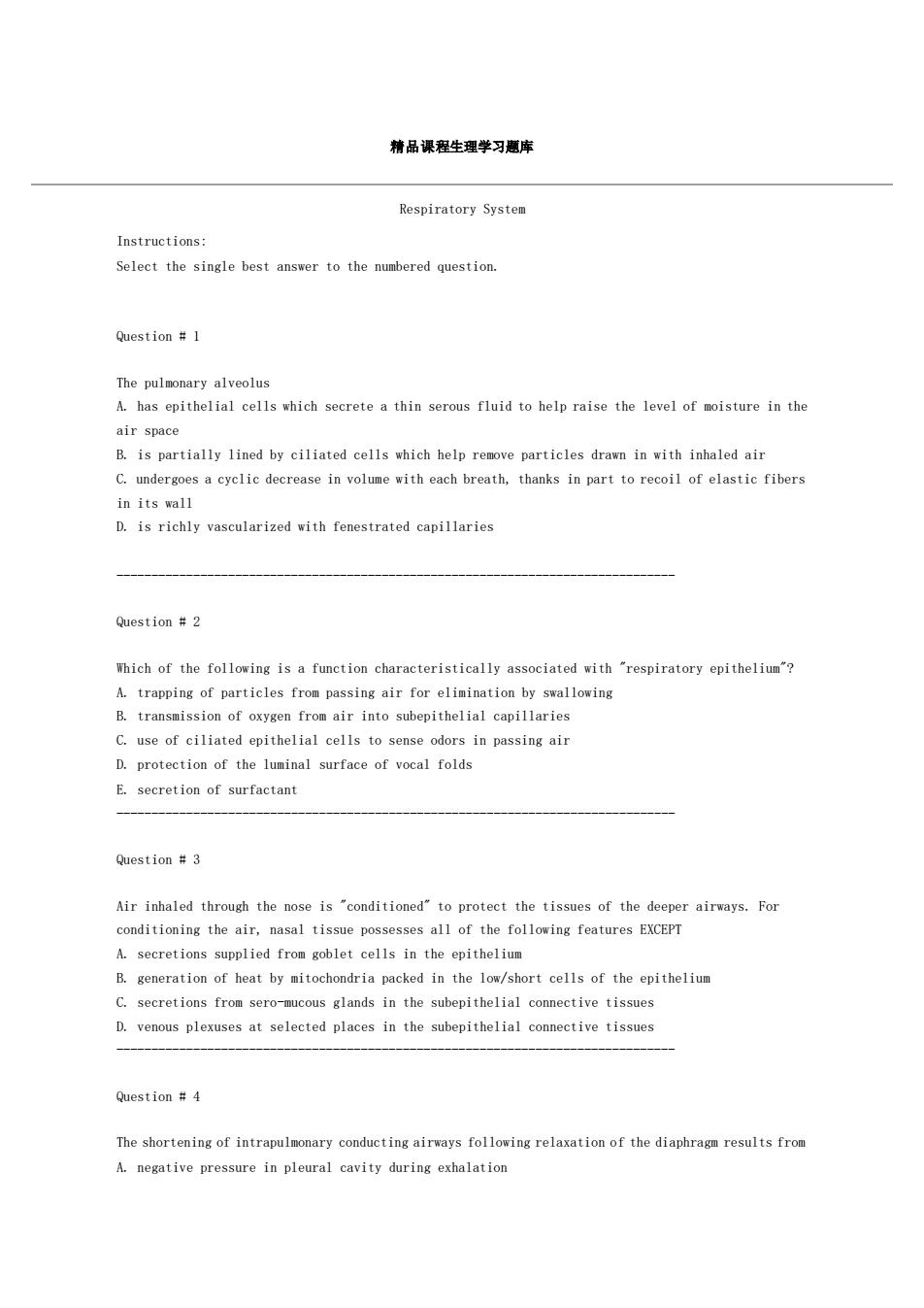
精品课程生理学习题库 Respiratory System Instructions: Select the single best answer to the numbered question. Question#1 The pulmonary alveolus A has epithelial cells which secrete a thin serous fluid to help raise the level of moisture in the air space B.is partially lined by ciliated cells which help remove particles drawn in with inhaled air C.undergoes a cyclic decrease in volume with each breath,thanks in part to recoil of elastic fibers in its wall D.is richly vascularized with fenestrated capillaries Question #2 which of the following is a function characteristically associated with"respiratory epithelium? A trapping of particles from passing air for elimination by swallowing ubepithelial C.use of ciliated epithelial cells to sense odors in passing air D.protection of the luminal surface of vocal folds E.secretion of surfactant Question#3 Air inhaled through the nose isconditioned to proteet the tissues of the deeper airways.For conditioning the air,nasal tissue possesses all of the following features EXCEPT A.secretions supplied from goblet cells in the epithelium B.generation of heat by mitochondria packed in the low/short cells of the epithelium C.secretions from sero-mucous glands in the subepithelial connective tissues D.venous plexuses at selected places in the subepithelial connective tissues Question#4 The shortening of intrapulmonary conducting airways following relaxation of the diaphragn results fro A.negative pressure in pleural cavity during exhalation
精品课程生理学习题库 Respiratory System Instructions: Select the single best answer to the numbered question. Question # 1 The pulmonary alveolus A. has epithelial cells which secrete a thin serous fluid to help raise the level of moisture in the air space B. is partially lined by ciliated cells which help remove particles drawn in with inhaled air C. undergoes a cyclic decrease in volume with each breath, thanks in part to recoil of elastic fibers in its wall D. is richly vascularized with fenestrated capillaries -------------------------------------------------------------------------------- Question # 2 Which of the following is a function characteristically associated with "respiratory epithelium"? A. trapping of particles from passing air for elimination by swallowing B. transmission of oxygen from air into subepithelial capillaries C. use of ciliated epithelial cells to sense odors in passing air D. protection of the luminal surface of vocal folds E. secretion of surfactant -------------------------------------------------------------------------------- Question # 3 Air inhaled through the nose is "conditioned" to protect the tissues of the deeper airways. For conditioning the air, nasal tissue possesses all of the following features EXCEPT A. secretions supplied from goblet cells in the epithelium B. generation of heat by mitochondria packed in the low/short cells of the epithelium C. secretions from sero-mucous glands in the subepithelial connective tissues D. venous plexuses at selected places in the subepithelial connective tissues -------------------------------------------------------------------------------- Question # 4 The shortening of intrapulmonary conducting airways following relaxation of the diaphragm results from A. negative pressure in pleural cavity during exhalation
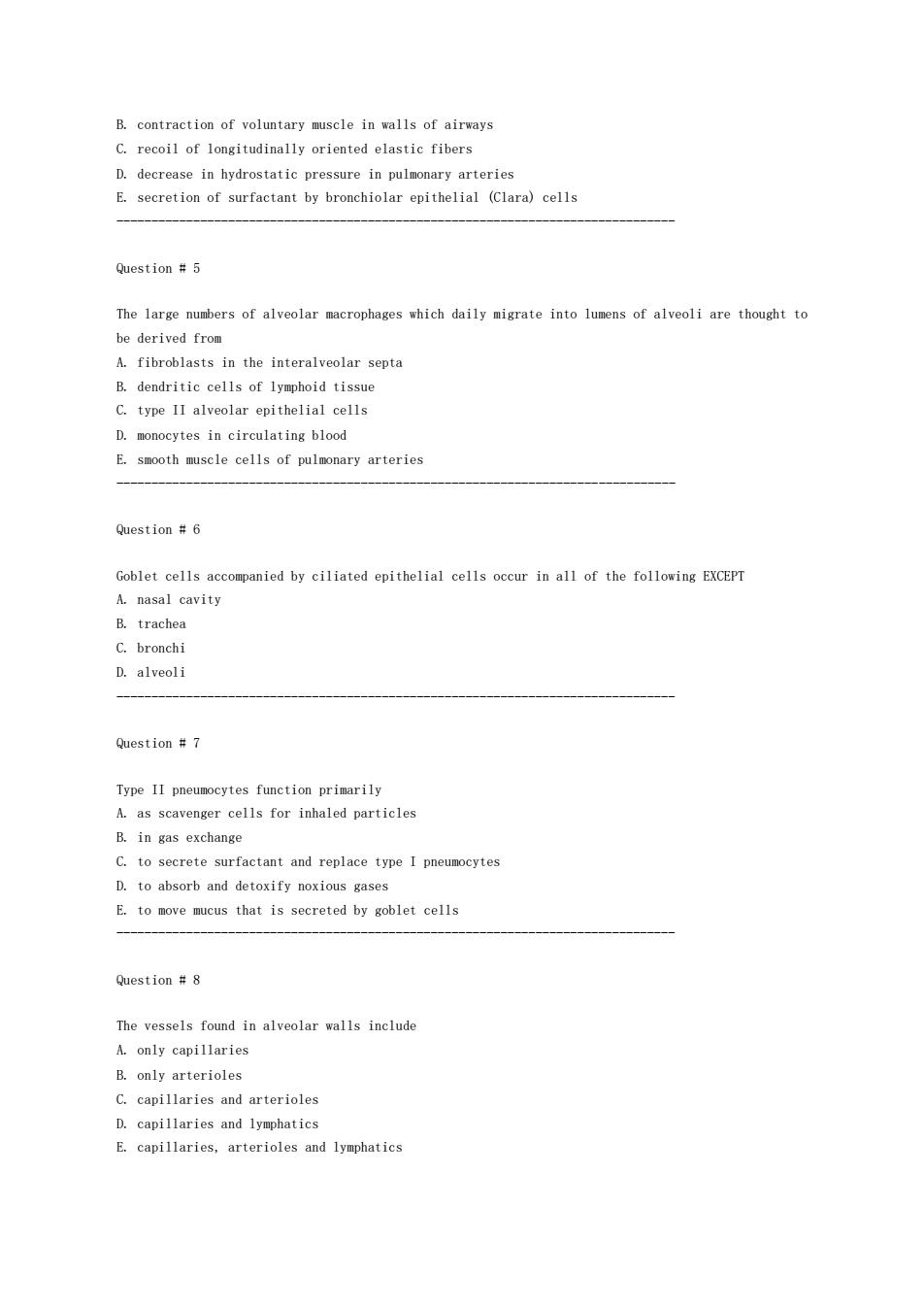
B.contraction of voluntary muscle in walls of airways C.recoil of longitudinally oriented elastic fibers D.decrease in hydrostatic pressure in pul ary arteries E.secretion of surfactant by bronchiolar epithelial (Clara)cells Question 5 The large nuabers of alveolar macrophages which daily migrate into lumens of alveoli are thought to be derived from A.fibroblasts in the interalveolar septa B.dendritic cells of lymphoid tissue C.type II alveolar epithelial cells D.monocytes in circulating blood E.smooth muscle cells of pulmonary arteries Question#6 Goblet cells accompanied by ciliated epithelial cells occur in all of the following EXCEPT A.nasal cavity B.trachea C.bronchi D.alveoli Question7 Type II pneumocytes function primarily A.as scavenger cells for inhaled particles B.in gas exchange factant and replace type I pneumocytes D.to absorb and detoxify noxious gases E.to move mucus that is secreted by goblet cells Question 8 The vessels found in alveolar walls include only capillar B.only arterioles C.capillaries and arterioles D.capillaries and lymphatics E.capillaries,arterioles and lymphatics
B. contraction of voluntary muscle in walls of airways C. recoil of longitudinally oriented elastic fibers D. decrease in hydrostatic pressure in pulmonary arteries E. secretion of surfactant by bronchiolar epithelial (Clara) cells -------------------------------------------------------------------------------- Question # 5 The large numbers of alveolar macrophages which daily migrate into lumens of alveoli are thought to be derived from A. fibroblasts in the interalveolar septa B. dendritic cells of lymphoid tissue C. type II alveolar epithelial cells D. monocytes in circulating blood E. smooth muscle cells of pulmonary arteries -------------------------------------------------------------------------------- Question # 6 Goblet cells accompanied by ciliated epithelial cells occur in all of the following EXCEPT A. nasal cavity B. trachea C. bronchi D. alveoli -------------------------------------------------------------------------------- Question # 7 Type II pneumocytes function primarily A. as scavenger cells for inhaled particles B. in gas exchange C. to secrete surfactant and replace type I pneumocytes D. to absorb and detoxify noxious gases E. to move mucus that is secreted by goblet cells -------------------------------------------------------------------------------- Question # 8 The vessels found in alveolar walls include A. only capillaries B. only arterioles C. capillaries and arterioles D. capillaries and lymphatics E. capillaries, arterioles and lymphatics
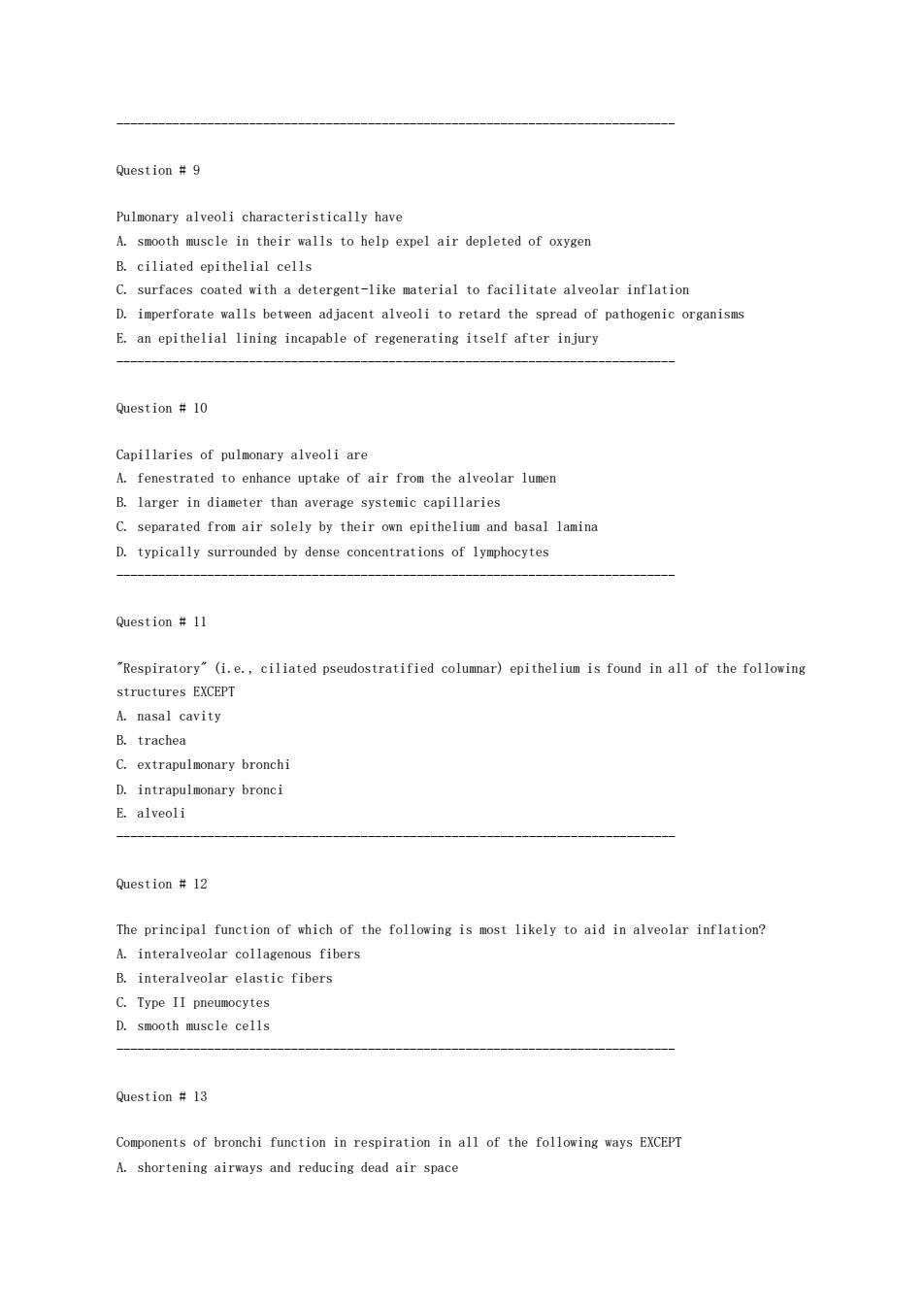
Question#9 Pumonary alveoli characteristically have A smooth muscle in their alls to help expel air depleted of oxygen B ciliated epithelial cells c surfaces coated with a detergent-like naterial to facilitate alveolar inflation D.imperforate walls between adjacent alveoli to retard the spread of pathogenic organis E an epithelial lining incapable of regenerating itself after injury Question¥10 Capillaries of pulmonary alveoli are A fenestrated to enhance uptake of air from the alveolar lumen B.larger in diameter than average systemic capillaries C.separated from air solely by their om epithelium and basal lamina D.typically surrounded by dense concentrations of lymphocytes Question 11 "Respiratory"(i.e.,ciliated pseudostratified columnar)epithelium is found in all of the following tructures Except cavity B.trachea C.extrapulmonary bronchi D.intrapulmonary bronci E.alveoli Question#12 The principal function of which of the following is most likely to aid in alveolar inflation? A interalveolar collagenous fibers B.interalveolar elastic fibers D smoothscle cells Question 13 Components of bronchi function in respiration in all of the following ways EXCEPT A.shortening airways and reducing dead air space
-------------------------------------------------------------------------------- Question # 9 Pulmonary alveoli characteristically have A. smooth muscle in their walls to help expel air depleted of oxygen B. ciliated epithelial cells C. surfaces coated with a detergent-like material to facilitate alveolar inflation D. imperforate walls between adjacent alveoli to retard the spread of pathogenic organisms E. an epithelial lining incapable of regenerating itself after injury -------------------------------------------------------------------------------- Question # 10 Capillaries of pulmonary alveoli are A. fenestrated to enhance uptake of air from the alveolar lumen B. larger in diameter than average systemic capillaries C. separated from air solely by their own epithelium and basal lamina D. typically surrounded by dense concentrations of lymphocytes -------------------------------------------------------------------------------- Question # 11 "Respiratory" (i.e., ciliated pseudostratified columnar) epithelium is found in all of the following structures EXCEPT A. nasal cavity B. trachea C. extrapulmonary bronchi D. intrapulmonary bronci E. alveoli -------------------------------------------------------------------------------- Question # 12 The principal function of which of the following is most likely to aid in alveolar inflation? A. interalveolar collagenous fibers B. interalveolar elastic fibers C. Type II pneumocytes D. smooth muscle cells -------------------------------------------------------------------------------- Question # 13 Components of bronchi function in respiration in all of the following ways EXCEPT A. shortening airways and reducing dead air space
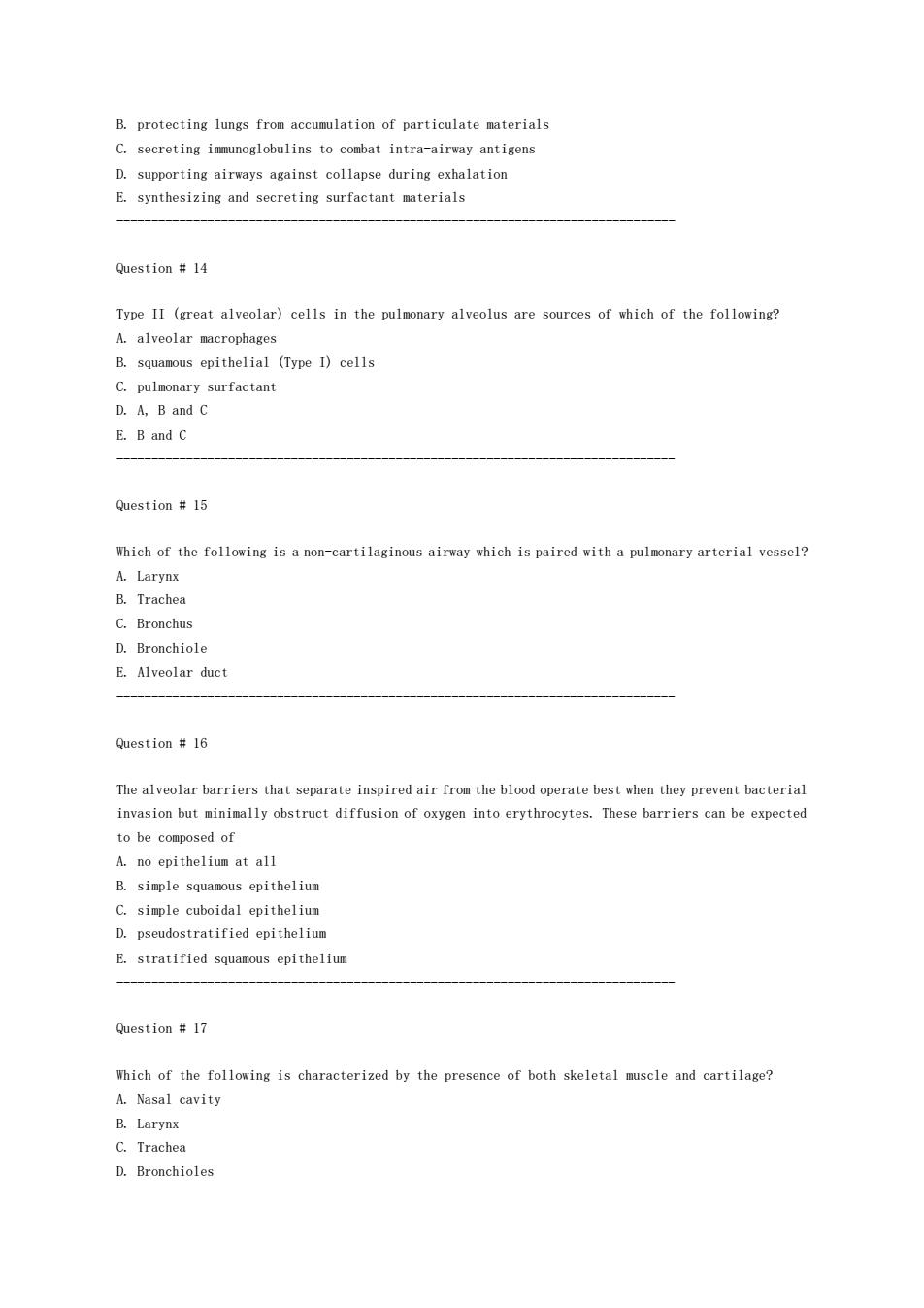
B.protecting lungs from accumulation of particulate materials C.secreting imunoglobulins to coabat intra-airway antigens E.synthesizing and secreting surfactant materials Question 14 Type II (great alveolar)cells in the pulmonary alveolus are sources of which of the following? A.alveolar macrophages C.pulmonary surfactant D.A,B and C E.B and C Question#15 Which of the following is a non-cartilaginous airway which is paired with a pulmonary arterial vessel? A.Larynx B.Trachea C.Bronchus D.Bronchiole E Alveolar duct Question 16 The alveolar barriers that separate inspired air from the blood operate best when they prevent bacterial invasion but mininally obstruct diffusion of oxygen into erythrocytes.These barriers can be expected to be composed of no epitheliu at all B.simple squamous epitheliu C.simple cuboidal epithelium D.pseudostratified epithelium E.stratified squamous epithelium Question#17 Which of the following is characterized by the presence of both skeletal muscle and cartilage? A Nasal cavity B.Larynx C.Trachea D.Bronchioles
B. protecting lungs from accumulation of particulate materials C. secreting immunoglobulins to combat intra-airway antigens D. supporting airways against collapse during exhalation E. synthesizing and secreting surfactant materials -------------------------------------------------------------------------------- Question # 14 Type II (great alveolar) cells in the pulmonary alveolus are sources of which of the following? A. alveolar macrophages B. squamous epithelial (Type I) cells C. pulmonary surfactant D. A, B and C E. B and C -------------------------------------------------------------------------------- Question # 15 Which of the following is a non-cartilaginous airway which is paired with a pulmonary arterial vessel? A. Larynx B. Trachea C. Bronchus D. Bronchiole E. Alveolar duct -------------------------------------------------------------------------------- Question # 16 The alveolar barriers that separate inspired air from the blood operate best when they prevent bacterial invasion but minimally obstruct diffusion of oxygen into erythrocytes. These barriers can be expected to be composed of A. no epithelium at all B. simple squamous epithelium C. simple cuboidal epithelium D. pseudostratified epithelium E. stratified squamous epithelium -------------------------------------------------------------------------------- Question # 17 Which of the following is characterized by the presence of both skeletal muscle and cartilage? A. Nasal cavity B. Larynx C. Trachea D. Bronchioles
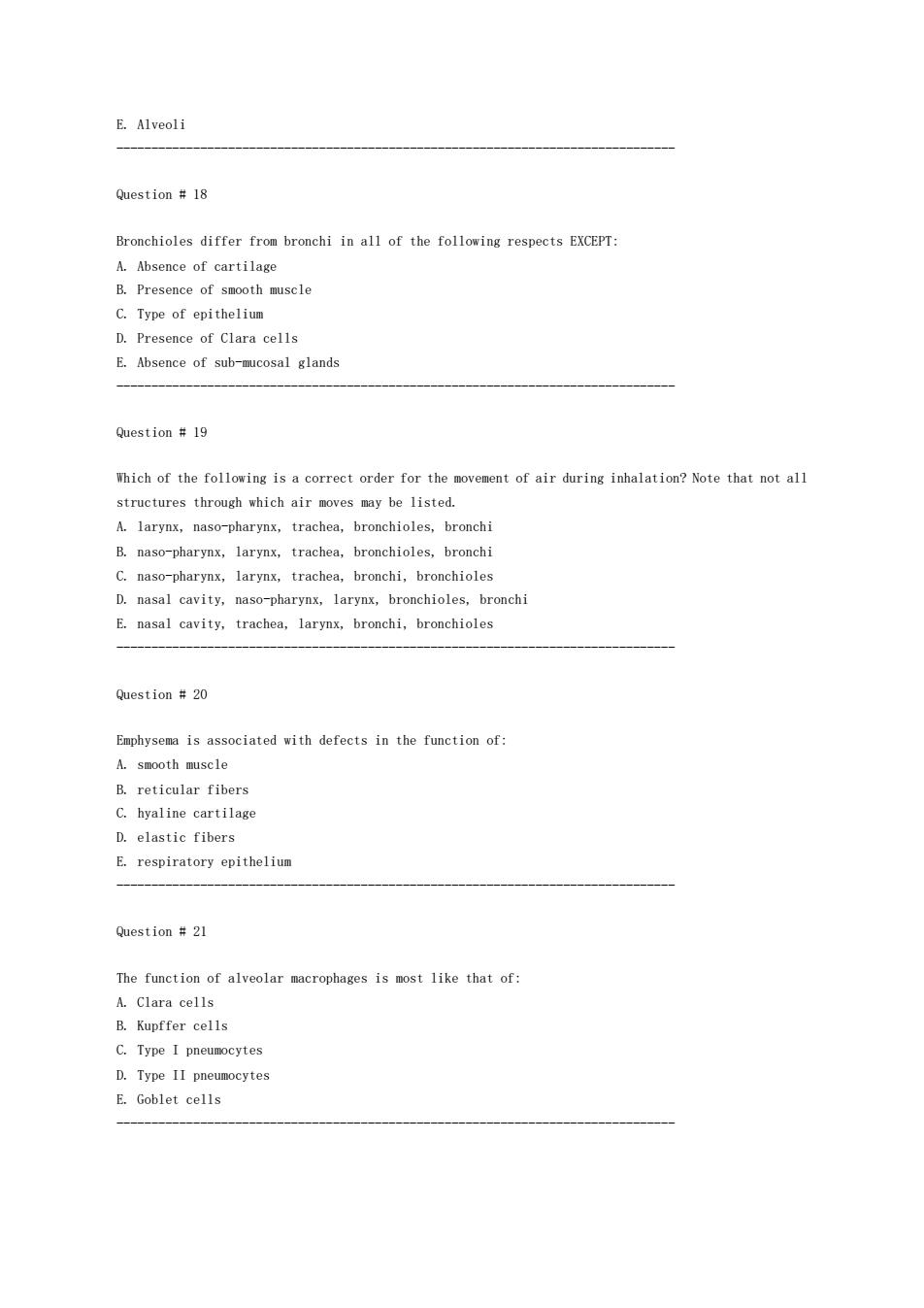
E Alveoli Bronchioles differ from bronchi in all of the following respects EXCEPT A.Absence of cartilage B.Presence of smooth muscle C.Type of epithelium D.Presence of Clara cells E.Absence of sub-mucosal glands Question#19 Which of the following is a correct order for the movement of air during inhalation?Note that not all structures through which air moves may be listed. A larynx,naso-pharynx.trachea,bronchioles,bronchi B.naso-pharynx,larynx,trachea,bronchioles,bronchi C.naso-pharynx,larynx,trachea,bronchi,bronchioles D.nasal cavity,naso-pharynx.larynx,bronchioles,bronchi E nasal cavity,trachea.larynx.bronchi,bronchioles Question#20 Emphysema is associated with defeets in the function of A.snooth nuscle B.reticular fibers C.hvaline cartilage D.elastic fibers Erespiratory epithelium Question 21 The function of alveolar macrophages is most like that of: A.Clara cells B.Kupffer cells C.Type I pneumocytes D.Type II pneumocytes E Goblet cells
E. Alveoli -------------------------------------------------------------------------------- Question # 18 Bronchioles differ from bronchi in all of the following respects EXCEPT: A. Absence of cartilage B. Presence of smooth muscle C. Type of epithelium D. Presence of Clara cells E. Absence of sub-mucosal glands -------------------------------------------------------------------------------- Question # 19 Which of the following is a correct order for the movement of air during inhalation? Note that not all structures through which air moves may be listed. A. larynx, naso-pharynx, trachea, bronchioles, bronchi B. naso-pharynx, larynx, trachea, bronchioles, bronchi C. naso-pharynx, larynx, trachea, bronchi, bronchioles D. nasal cavity, naso-pharynx, larynx, bronchioles, bronchi E. nasal cavity, trachea, larynx, bronchi, bronchioles -------------------------------------------------------------------------------- Question # 20 Emphysema is associated with defects in the function of: A. smooth muscle B. reticular fibers C. hyaline cartilage D. elastic fibers E. respiratory epithelium -------------------------------------------------------------------------------- Question # 21 The function of alveolar macrophages is most like that of: A. Clara cells B. Kupffer cells C. Type I pneumocytes D. Type II pneumocytes E. Goblet cells --------------------------------------------------------------------------------
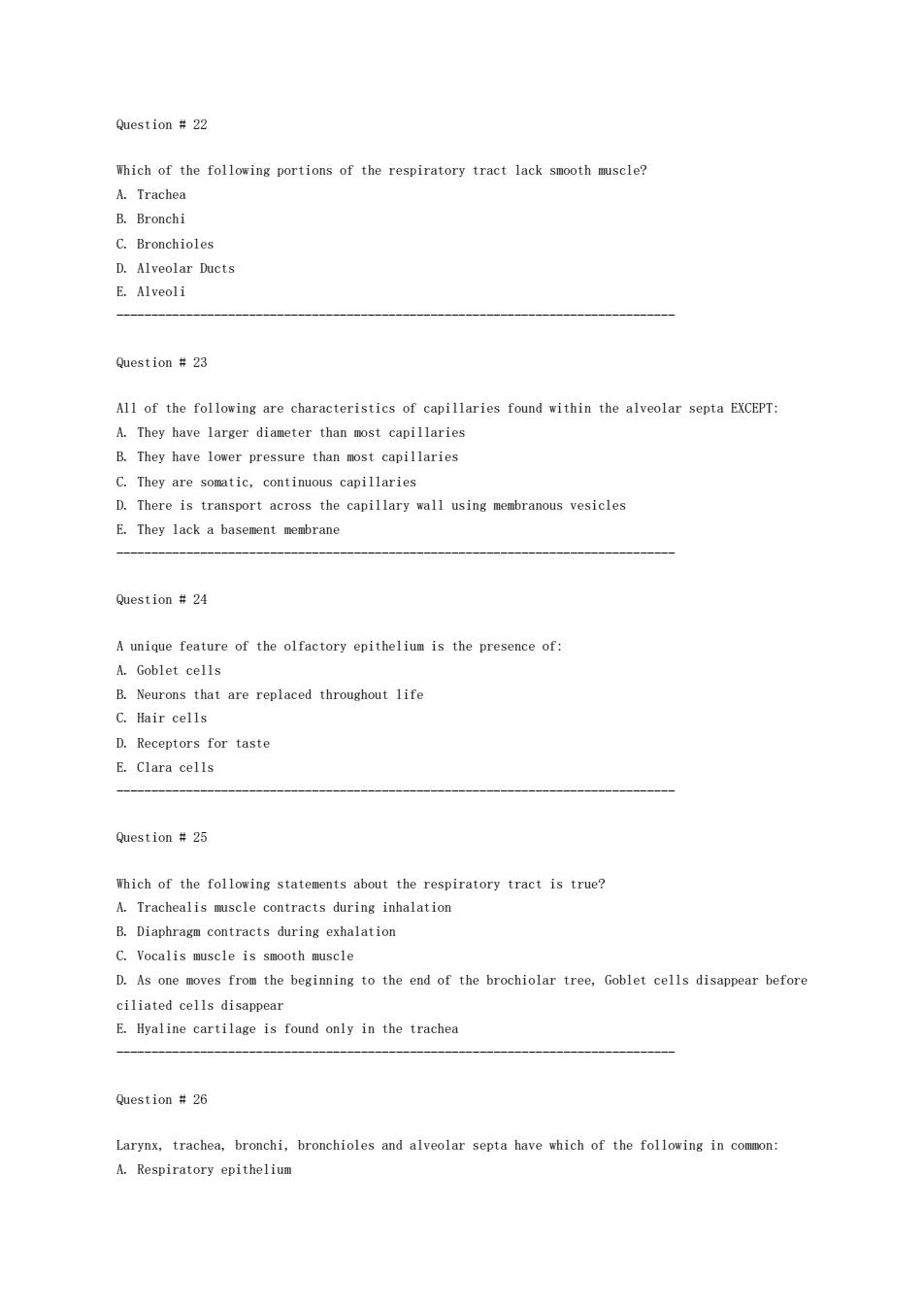
Question 22 Which of the following portions of the respiratory tract lack smooth muscle? A.Trachea B.Bronchi C.Bronchioles D.Alveolar Ducts E.Alveoli All of the following are characteristics of capillaries found within the alveolar septa EXCEPT A They have larger dianeter than most capillaries B.They have lower pressure than most capillaries C.They are somatic.continuous capillaries D.There is transport across the capillary wall using menbranous vesicles E.They lack a basement membrane Question #24 A unique feature of the olfactory epithelium is the presence of: A Goblet cells B.Neurons that are replaced throughout life C.Hair cells D.Receptors for taste E.Clara cells Question #25 hich of the following statements about the respiratory tract is true? A.Trachealis muscle contracts during inhalation B.Diaphragm contracts during exhalation C.Vocalis muscle is smooth muscle D.As one noves from the beginning to the end of the brochiolar tree.Goblet cells disappear before ciliated cells disappea E.Hyaline cartilage is found only in the trachea Question#26 Larynx,trachea,bronchi.bronchioles and alveolar septa have which of the following in coamon: A.Respiratory epithelium
Question # 22 Which of the following portions of the respiratory tract lack smooth muscle? A. Trachea B. Bronchi C. Bronchioles D. Alveolar Ducts E. Alveoli -------------------------------------------------------------------------------- Question # 23 All of the following are characteristics of capillaries found within the alveolar septa EXCEPT: A. They have larger diameter than most capillaries B. They have lower pressure than most capillaries C. They are somatic, continuous capillaries D. There is transport across the capillary wall using membranous vesicles E. They lack a basement membrane -------------------------------------------------------------------------------- Question # 24 A unique feature of the olfactory epithelium is the presence of: A. Goblet cells B. Neurons that are replaced throughout life C. Hair cells D. Receptors for taste E. Clara cells -------------------------------------------------------------------------------- Question # 25 Which of the following statements about the respiratory tract is true? A. Trachealis muscle contracts during inhalation B. Diaphragm contracts during exhalation C. Vocalis muscle is smooth muscle D. As one moves from the beginning to the end of the brochiolar tree, Goblet cells disappear before ciliated cells disappear E. Hyaline cartilage is found only in the trachea -------------------------------------------------------------------------------- Question # 26 Larynx, trachea, bronchi, bronchioles and alveolar septa have which of the following in common: A. Respiratory epithelium
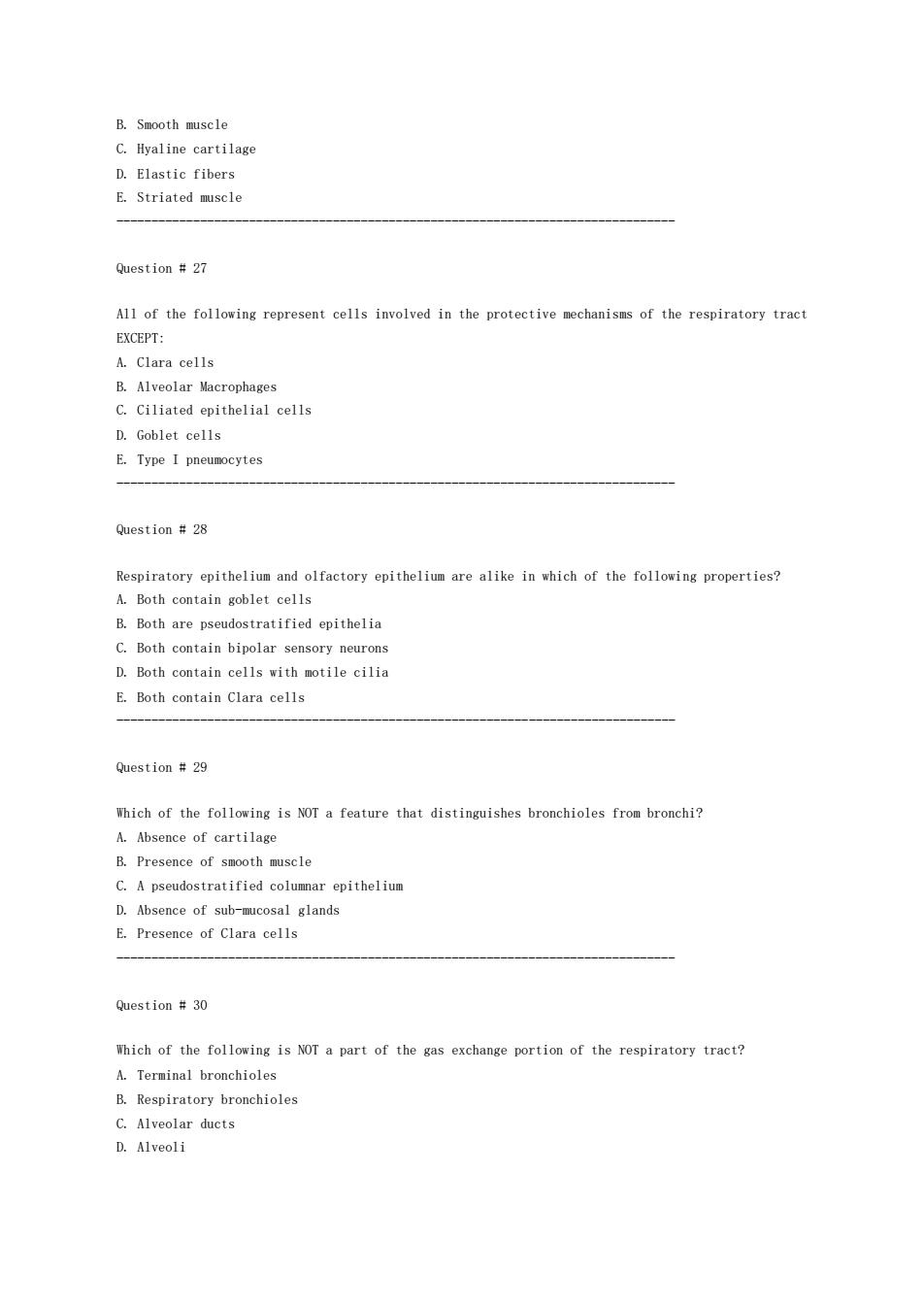
B.Snooth nuscle C.Hyaline cartilage D.Elastic fibers E Striated muscle Question 27 All of the following represent cells involved in the protective mechanisms of the respiratory tract EXCEPT: A Clara cells B.Alveolar Macrophages C.Ciliated epithelial cells D.Goblet cells E.Type I pneumocytes Respiratory epithelium and olfactory epithelium are alike in which of the following properties? A Both contain goblet cells B.Both are pseudostratified epithelia C.Both contain bipolar sensor Both contain cells with motile cilia E.Both contain Clara cells Question#29 Which of the following is NOT a feature that distinguishes bronchioles from bronchi? A.Absence of cartilage B.Presence of smooth muscle C.A pseudostratified columnar epithelium D.Absence of sub-mucosal glands E.Presence of Clara cells Which of the following is NOT a part of the gas exchange portion of the respiratory tract? A.Terminal bronchioles B.Respiratory bronchioles C.Alveolar ducts D.Alveoli
B. Smooth muscle C. Hyaline cartilage D. Elastic fibers E. Striated muscle -------------------------------------------------------------------------------- Question # 27 All of the following represent cells involved in the protective mechanisms of the respiratory tract EXCEPT: A. Clara cells B. Alveolar Macrophages C. Ciliated epithelial cells D. Goblet cells E. Type I pneumocytes -------------------------------------------------------------------------------- Question # 28 Respiratory epithelium and olfactory epithelium are alike in which of the following properties? A. Both contain goblet cells B. Both are pseudostratified epithelia C. Both contain bipolar sensory neurons D. Both contain cells with motile cilia E. Both contain Clara cells -------------------------------------------------------------------------------- Question # 29 Which of the following is NOT a feature that distinguishes bronchioles from bronchi? A. Absence of cartilage B. Presence of smooth muscle C. A pseudostratified columnar epithelium D. Absence of sub-mucosal glands E. Presence of Clara cells -------------------------------------------------------------------------------- Question # 30 Which of the following is NOT a part of the gas exchange portion of the respiratory tract? A. Terminal bronchioles B. Respiratory bronchioles C. Alveolar ducts D. Alveoli
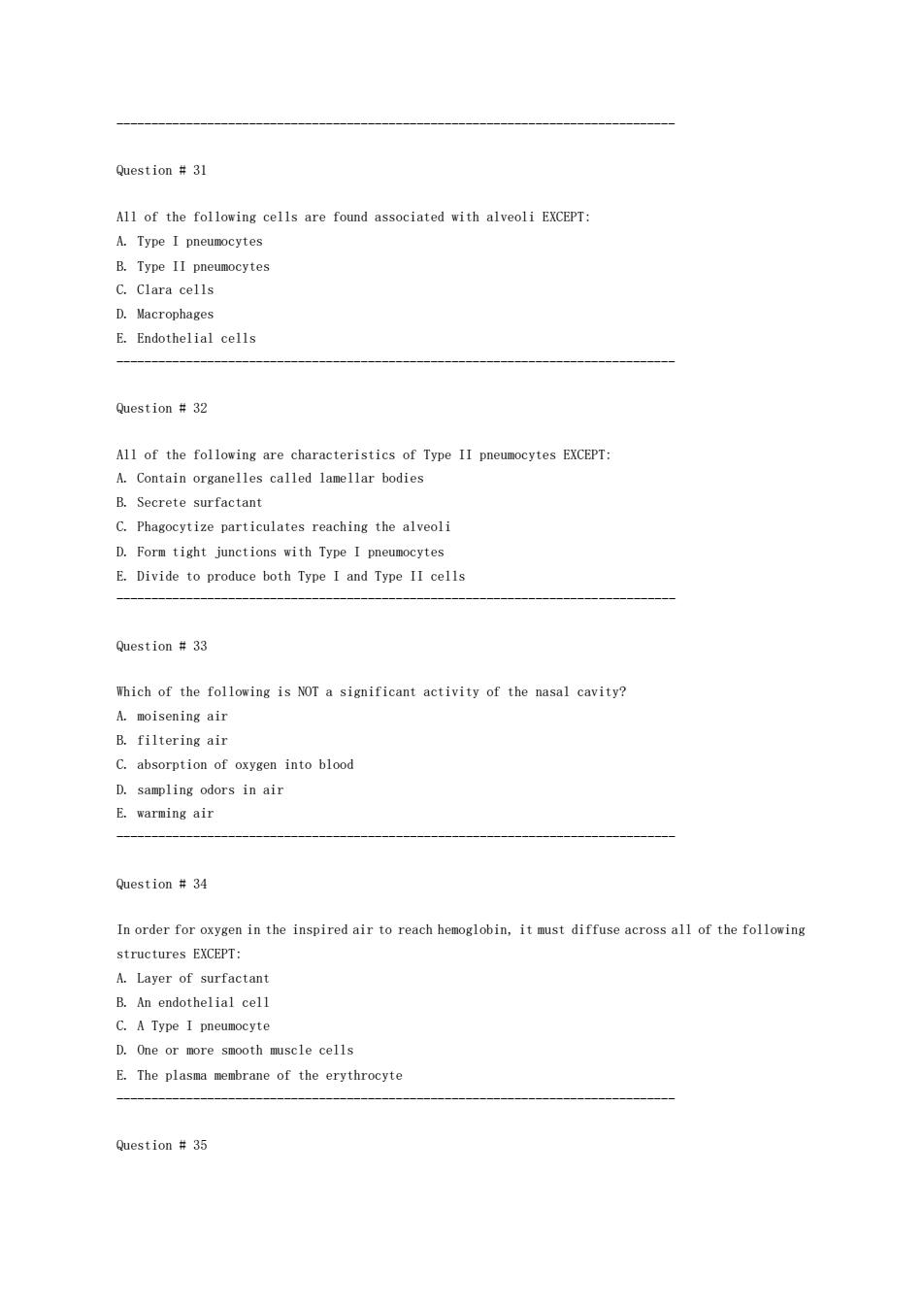
Question #31 All of the following cells are found associated with alveoli EXCEPT A.Type I pneumocytes B.Type II pneumocytes C.Clara cells D.地acrophages E Endothelial cells Question#32 All of the following are characteristics of Type II pneumocytes EXCEPT: A.Contain organelles called lamellar bodies B.Secrete surfactant C.Phagocytize particulates reaching the alveoli D.Form tight junctions with Type I pneumocytes E.Divide to produce both Type I and Type II cells Question #33 Which of the following is NOT a significant activity of the nasal cavity? A.moisening air B.filtering air C.absorption of oxygen into blood D.sampling odors in air E.warming air Question#34 In order for oxygen in the inspired air to reach hemoglobin,it must diffuse across all of the following structures EXCEPT: A.Laver of surfactant B.An endothelial cell C.A Type I pneumocyte D On or more oth muscle cells E.The plasma membrane of the erythrocyte Question#35
-------------------------------------------------------------------------------- Question # 31 All of the following cells are found associated with alveoli EXCEPT: A. Type I pneumocytes B. Type II pneumocytes C. Clara cells D. Macrophages E. Endothelial cells -------------------------------------------------------------------------------- Question # 32 All of the following are characteristics of Type II pneumocytes EXCEPT: A. Contain organelles called lamellar bodies B. Secrete surfactant C. Phagocytize particulates reaching the alveoli D. Form tight junctions with Type I pneumocytes E. Divide to produce both Type I and Type II cells -------------------------------------------------------------------------------- Question # 33 Which of the following is NOT a significant activity of the nasal cavity? A. moisening air B. filtering air C. absorption of oxygen into blood D. sampling odors in air E. warming air -------------------------------------------------------------------------------- Question # 34 In order for oxygen in the inspired air to reach hemoglobin, it must diffuse across all of the following structures EXCEPT: A. Layer of surfactant B. An endothelial cell C. A Type I pneumocyte D. One or more smooth muscle cells E. The plasma membrane of the erythrocyte -------------------------------------------------------------------------------- Question # 35

Larynx,trachea.bronchioles and alveolar septa have which of the following in common? A Respiratory epitheliu B.Snooth muscle C.Hyaline cartilage D.Striated muscle E Elastic fibers In order for oxygen to diffuse from the alveolar air spaces to the site of its binding to hemoglobin, it must diffuse across how many plasma membranes? A.2 B.3 C.4 n. E.6 Question#37 There are some interesting similarities and contrasts in the structural organization of the glomerular filtration barrier versus the alveolar gas diffusion barrier.In this regard,which of the following is NOT a true statement? A.Both the filtration barrier and the gas diffusion barrier contain two epithelial layers. B.Glomerular capillaries are fenetrated capillaries shile alveolar capillaries are continuous canillaries. C.Alveolar capillaries have a smaller diameter and a higher hydrostatic pressure than gloerular D.Both the filtration barrier and the gas diffusion barrier include at least one basenent membrane E Type I pneumocytes in the alveolus are connected by tight (sealing)junctions while the glomerular podocytes are not. Answer 1.C2.A3.B4C5.D6.D7.C8A9.C10.B 11.E12.C13.E14.E15.D16.B17.B18.B19.C20.D 21.B22.E23.E24.B25.D26.D27.E28.B29.B30.A 31.C32.C33.C34.D35.E36.D37.C
Larynx, trachea, bronchioles and alveolar septa have which of the following in common? A. Respiratory epithelium B. Smooth muscle C. Hyaline cartilage D. Striated muscle E. Elastic fibers -------------------------------------------------------------------------------- Question # 36 In order for oxygen to diffuse from the alveolar air spaces to the site of its binding to hemoglobin, it must diffuse across how many plasma membranes? A. 2 B. 3 C. 4 D. 5 E. 6 -------------------------------------------------------------------------------- Question # 37 There are some interesting similarities and contrasts in the structural organization of the glomerular filtration barrier versus the alveolar gas diffusion barrier. In this regard, which of the following is NOT a true statement? A. Both the filtration barrier and the gas diffusion barrier contain two epithelial layers. B. Glomerular capillaries are fenetrated capillaries while alveolar capillaries are continuous capillaries. C. Alveolar capillaries have a smaller diameter and a higher hydrostatic pressure than glomerular capillaries D. Both the filtration barrier and the gas diffusion barrier include at least one basement membrane. E. Type I pneumocytes in the alveolus are connected by tight (sealing) junctions while the glomerular podocytes are not. -------------------------------------------------------------------------------- Answer: 1.C 2.A 3.B 4.C 5.D 6.D 7.C 8.A 9.C 10.B 11.E 12.C 13.E 14.E 15.D 16.B 17.B 18.B 19.C 20.D 21.B 22.E 23.E 24.B 25.D 26.D 27.E 28.B 29.B 30.A 31.C 32.C 33.C 34.D 35.E 36.D 37.C